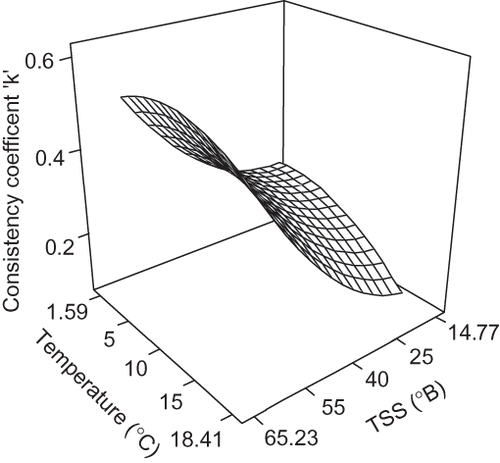Abstract
Central composite design was used to analyze the effect of particle size (0.075, 0.15, 0.25, 0.355, 0.425 mm), temperature (1.6, 5, 10, 15, 18.4°C) and total soluble solids (14.77, 25, 40, 50, 65.23°Brix) on the rheological properties of watermelon juice. Experimental values of consistency coefficient k, varied from 0.178–0.628 Pa sn and flow behavior index n from 0.281 to 0.949. Regression equation was computed and used to predict the values of k and n. Results revealed that coefficient of determination (R2) and standard error for consistency coefficient k were 0.84 and 0.043 and for flow behavior index n were 0.42 and 0.102 respectively. Surface graphs showed that k value increased with increase in total soluble solids and particle size while decreased with temperature.
INTRODUCTION
Watermelon (Citrullus vulgaris) is a native plant of tropical Africa and belongs to cucurbitaceae family. The production of watermelon in India was 255 thousand tons in 2008.[Citation1] Watermelon fruit contained 42% juice, 33.6% rind and 23.6% pomace (including seeds) on wet basis.[Citation2] Watermelon provides sufficient amounts of thiamine, niacin, riboflavin, ascorbic acid, calcium, phosphorous, iron, potassium (diuretic properties) and calories.[Citation3–4] It helps in quenching the inflammation that contributes to conditions like asthma, atherosclerosis, diabetes, colon cancer, and arthritis.
The majority of watermelon is consumed fresh and limited products based on its fruit juice are available in the market. Watermelon juice concentrate could be a better alternate to handle the surplus produce for subsequent use. Watermelon juice and its products can differ widely in their soluble solids concentration, particle size and flow properties. The rheological data are used in designing fluid handling and heat transfer equipments.[Citation5–6] Further these data have advantages over usual consistency measurement in characterizing product quality.[Citation7] It is hard to predict the precise magnitudes of viscosity of fluid foods because of wide variation in their composition. Particle size is important due to its effect on viscosity and appearance.
Viscosity also influences the products quality and affects consumer acceptability. Response surface methodology was commonly used to analyze the effect of different variables at various levels. Sogi[Citation2] studied the effect of temperature and soluble solid content on rheological properties of the watermelon juice. Effect of temperature, total soluble solids, pH and α-amylase concentration on rheological characterization of papaya puree was studied using response surface methodology.[Citation8] In current study effect of particle size, temperature and total soluble solids on the rheological properties of watermelon juice was investigated using response surface methodology.
MATERIALS AND METHODS
Material
The ripe watermelons (“Sugar Baby”) of about 3.0 kg per fruit were procured from local market of Amritsar, Punjab (India).
Physicochemical Analysis
Total soluble solids were quantified by using Abbe Mat Refractometer (Milton Roy Co., USA) at 21°C. Titrable acidity (as anhydrous citric acid) was determined using a pH meter (Elico, India). Reducing and total sugars were determined according to Lane and Eyon method.[Citation9]
Sample Preparation
Fruits were cut, peeled and extracted by using Screw Juice Extractor (Kalsi Industries, India). The juice was then passed through various sieves (0.425 mm, 0.355 mm, 0.25 mm, 0.15 mm and 0.075 mm) to obtain samples of different particle size. These samples were concentrated to various total soluble solids 14.8, 25, 40, 55 and 65.2°B using Rotary Vacuum Evaporator (Perfit, India) at 100-mm Hg Pressure.
Rheological Measurements
A programmable Rheometer DV-III (Brookfield Engg. Laboratory Inc, U.S.A.) equipped with a temperature controller (TC 500, Brookfield Engeering Laboratory Inc., USA.) was used for the rheological study. Shear stress and shear rate values were observed for juice sample having different soluble solids and particle size at different temperatures (1.59, 5, 10, 15, and 18.41°C). The shear rate ranged between 0.002 and 1875 sec−1.
Power Law model, extensively used to describe the flow behavior of fluid foods[Citation5, Citation7, Citation10–11] was employed in the present study. The equation can be written as:
Experimental Design
Five levels of each process variables Particle size (mm) (X1), temperature (°C) (X2), total soluble solid (°B) (X3) were selected. Two response variables, i.e., consistency coefficient (k) and flow behavior index (n) were obtained from Power law model (EquationEq. (1)).
Statistical Analysis
A central composite design for three independent variables was selected.[Citation12] The regression equation was computed from independent and response variables using a statistical package (Mini Tab Inc., USA). Statistical analysis of coefficients of regression equation and predicted values was also carried out. Surface graphs for predicted values of response variable were plotted.
RESULTS AND DISCUSSION
Physicochemical Analysis
Total soluble solids of watermelon juice was found to be 7.2°B. Similar results for total soluble solids of watermelon juice were found range between 6.8–7.2°B.[Citation13] The pH and acidity of watermelon juice was found to be 5.7 and 0.0758%. Earlier studies on watermelon juice reported acidity in the range of 0.06–0.09%. Reducing sugars and total sugars of watermelon juice were found to be 3.96 and 5.89%, respectively. Earlier studies reported values for reducing and total sugars of watermelon juice varied between 3.47 and 3.78% and 5.22–5.29%, respectively.[Citation13]
Rheological Properties
Watermelon juice concentrate was analyzed for shear stress and shear rate following different combinations of independent variables as per central composite design. Power law model was used to compute response variables consistency coefficient (k) and flow behavior index (n) from shear stress and shear rate data.
The experimental value of ‘k’ obtained with different combinations of independent variable varied from 0.178–0.628, whereas that of ‘n’ varied from 0.281–0.949 (). The data pertaining to independent and response variables were analyzed to develop second order model for consistency coefficient ‘k’ and flow behavior index ‘n’.[Citation14]
Table 1 Central composite design arrangement for independent variables (Particle size, mm (X1), temperature °C (X2), TSS, °B (X3)) and their responses (consistency coefficient, Pa sn (k), flow behavior index (n)) (n = 3)
Consistency Coefficient (k)
The regression model developed for consistency coefficient was as follows:
Figure 1 Effect of particle size and temperature on consistency coefficient ‘k’ of watermelon juice having TSS of 40°B.
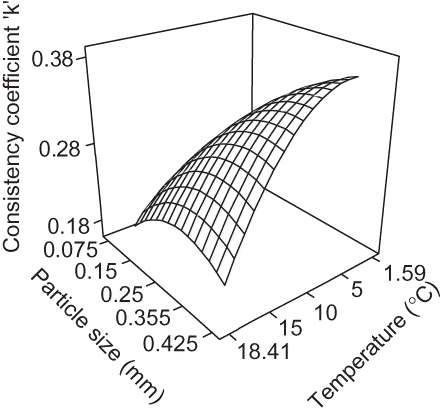
Studies on the effect of hydrocolloids in tamarind sauce showed that as the temperature increased the ‘k’ decreased.[Citation16] Studies on the effect of temperature (25–70°C) on the rheological characteristics of garlic and onion pastes reported that ‘k’ decrease from 279–134 Pa.sn for garlic paste and 68–30 Pa.sn for onion paste.[Citation17] The results obtained in the present study were in agreement with the above findings.
The effect of particle size and total soluble solids on the ‘k’ value at 10°C revealed that when soluble solids of juice increased from 14.77 to 65.23°B and particle size increased from 0.075 to 0.425 mm the ‘k’ increased slightly (). However increase in ‘k’ was higher with soluble solids as compared to particle size. The highest value of ‘k’ was obtained at higher particle size and higher soluble solids.
Figure 2 Effect of particle size and total soluble solids on consistency coefficient ‘k’ of watermelon juice at 10°C.
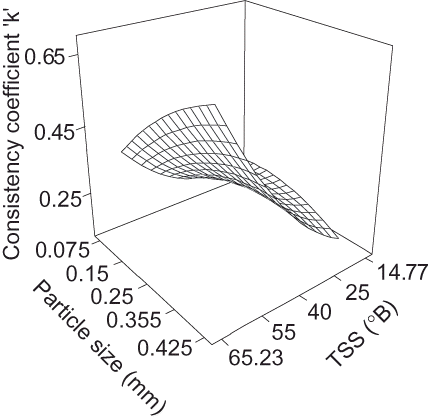
The effect of temperature and total soluble solids on the ‘k’ value having 0.25 mm particle size that as the total soluble solids increased from 14.77 to 65.23°B, the ‘k’ increased (). While as the temperature increased from 1.59 to 18.41°C the ‘k’ decreased. The change in soluble solids had greater effect on the ‘k’ values than the temperature.
Flow Behavior Index (n)
The results indicated that first order regression coefficients (b1, b2, and b3), second order (b11, b22, and b33) coefficients and interaction coefficients (b12, b13, and b23) for ‘n’ were not significant at 1% levels of significance. The coefficient of determination for flow behavior index was 42.2% and standard error was 0.102. The scattered plot revealed that model was adequate to explain the behavior of response variable. The regression equation obtained for flow behavior index was as follows:
Figure 4 Effect of particle size and temperature on flow behavior index ‘n’ of watermelon juice having TSS of 40°B.
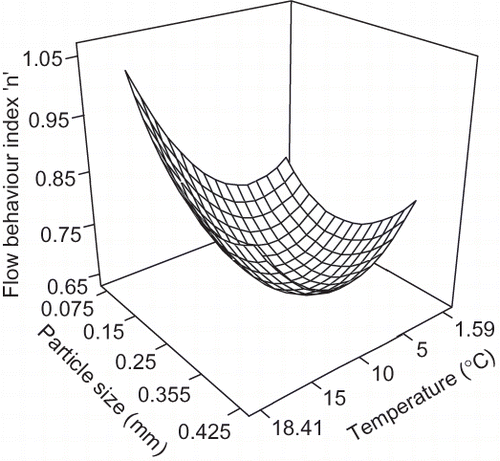
Figure 5 Effect of total soluble solids and particle size on flow behavior index ‘n’ of watermelon juice at 10°C.
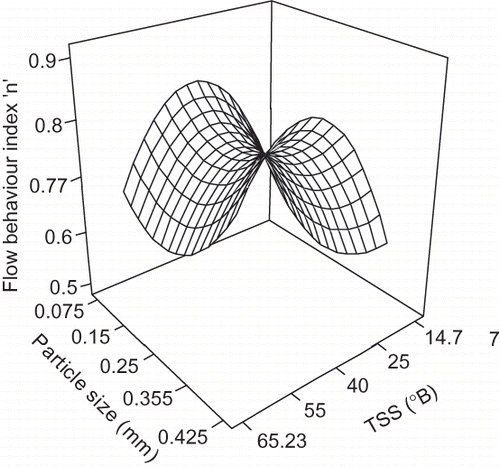
Figure 6 Effect of total soluble solids and temperature on flow behavior index ‘n’ of water melon juice having particle size of 0.25 mm.
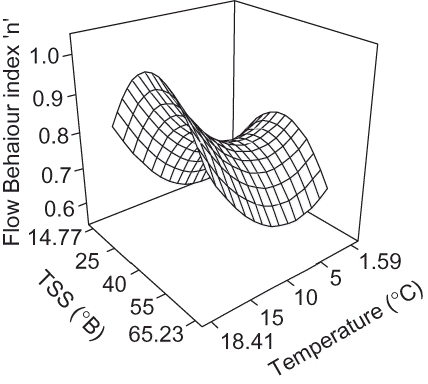
Previous studies showed that flow behavior index (n) was decreased as temperature was increased from 25 to 70°C in the range from 0.14 to 0.12 for garlic paste, and it increased from 0.16 to 0.19 in the same temperature range for onion paste. These values indicated that the products were pseudoplastic in nature.[Citation17] Studies on the rheological properties of plum concentrate revealed that as the sugar concentration in the pulp was increased from 25–45°B, the ‘n’ values also increased from 0.25 to 0.34. The flow behavior index (n) of plum concentrate varied from 0.23–0.34 indicating pseudoplastic nature of the paste. The magnitude of ‘n’ increased with sugar concentration and showed no definite trends with concentration.[Citation18]
CONCLUSION
Results concluded that the temperature, particle size, and soluble solids have considerable effect on the rheological properties. Consistency coefficient ‘k’ value increased with increase in total solids and particle size whereas it decreased with increase in temperature. Flow behavior index ‘n’ value did not follow a particular pattern with change in temperature, particle size, and soluble solids. These results could be used to judge the behavior of watermelon juice under various processing conditions during the manufacture of watermelon juice concentrate.
REFERENCES
- Food and Agriculture Organization (FAO). Statistical Data. 2008. FAO http://www.fao.org/site/567/default.aspx#ancor (http://www.fao.org/site/567/default.aspx#ancor)
- Sogi , D.S. 2003 . Effect of Concentration and Temperature on Viscosity of Watermelon Juice . Journal of Food Science and Technology , 40 ( 5 ) : 509 – 511 .
- Howard , F.D. , Mc Gillivray , J.H. and Yamaguchi , M. 1962 . California Agriculture Stn. Bull. , 44 : 788
- Huor , S.S. , Ahmed , E.M. , Rao , P.V. and Cornell , J.A. 1980 . Formulation and Sensory Evaluation of a Fruit Containing Watermelon Juice . Journal of Food Science , 45 : 809 – 813 .
- Holdsworth , S.D. 1971 . Applicability of Rheological Models to the Interpretation of Flows and Processing Behaviour of Fluid Food Products . Journal of Texture Studies , 2 : 393 – 418 .
- Ilicali , D.R.C. 1985 . Correlation for the Consistency Coefficients of Apricot and Peal Purees . Journal of Food Engineering , 8 : 47 – 51 .
- Harper , J.C. and Sahrigi , A.F. 1965 . Viscometeric Behaviour of Tomato Concentrates. Journal of Food Science and Technology , 30 : 470 – 476 .
- Ahmed , J. and Ramaswamy , H.S. 2004 . Response Surface Methodology in Rheological Characterization of Papaya Puree . International Journal of Food Properties , 7 ( 1 ) : 45 – 58 .
- Ranganna , S. 1986 . Hand Book of Analysis and Quality Control for Fruit and Vegetable Products , 2nd , 1 – 30 . New Delhi : Tata McGraw Hill .
- Rao , M.A. , Bourne , M.D. and Cooley , H.J. 1981 . Flow Properties of Tomato Concentrates . Journal of Texture Studies , 12 : 521 – 538 .
- Ahmed , J. , Gangopadhya , H. and Shivhare . 1999 . U.S. Effect of Temperature on Rheological Characteristics of Green Chilli Puree . Journal of Food Science and Technology , 36 : 352 – 354 .
- Gomez , K.A. and Gomez , A.A. 1984 . Statistical Procedures for Agricultural Research , 2nd , 357 – 423 . New York : John Wiley and Sons .
- Sharma , R. , Kaur , D. , Oberoi , D.P.S. and Sogi , D.S. 2008 . Thermal Degradation Kinetics of Pigments and Visual Color in Watermelon Juice . International Journal of Food Properties , 11 : 439 – 449 .
- Wanasundara , P.K.J.P.D. and Shahidi , F. 1996 . Optimization of Hexa-metaphosphate Assisted Extraction of Flaxseed Proteins using response surface methodology . Journal of Food Science , 61 : 604 – 607 .
- Mizubuti , I.Y. , Junior , O.B. , Souza , L.W.O. , Silva , R.S.S.F. and Ida , E.L. 2000 . Response Surface Methodology for Extraction Optimization of Pigeon Pea Protein . Food Chemistry , 70 : 259 – 265 .
- Gujral , H.S. , Sharma , P. , Singh , N. and Sogi , D.S. 2001 . Effect of Hydrocolloids on the Rheology of Tamarind Sauce . Journal of Food Science and Technology , 38 : 314 – 318 .
- Ahmed , J. 2000 . Effect of Temperature on Rheological Characteristics of Garlic and Onion Pastes . Journal of Food Science and Technology , 37 : 409 – 411 .
- Ahmed , J. 1998 . Rheological Properties of Plum Concentrate . Journal of Food Science and Technology , 35 : 339 – 341 .
